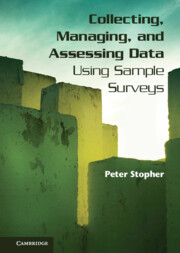Book contents
- Frontmatter
- Contents
- Figures
- Tables
- Acknowledgements
- 1 Introduction
- 2 Basic statistics and probability
- 3 Basic issues in surveys
- 4 Ethics of surveys of human populations
- 5 Designing a survey
- 6 Methods for conducting surveys of human populations
- 7 Focus groups
- 8 Design of survey instruments
- 9 Design of questions and question wording
- 10 Special issues for qualitative and preference surveys
- 11 Design of data collection procedures
- 12 Pilot surveys and pretests
- 13 Sample design and sampling
- 14 Repetitive surveys
- 15 Survey economics
- 16 Survey implementation
- 17 Web-based surveys
- 18 Coding and data entry
- 19 Data expansion and weighting
- 20 Nonresponse
- 21 Measuring data quality
- 22 Future directions in survey procedures
- 23 Documenting and archiving
- References
- Index
11 - Design of data collection procedures
Published online by Cambridge University Press: 05 June 2012
- Frontmatter
- Contents
- Figures
- Tables
- Acknowledgements
- 1 Introduction
- 2 Basic statistics and probability
- 3 Basic issues in surveys
- 4 Ethics of surveys of human populations
- 5 Designing a survey
- 6 Methods for conducting surveys of human populations
- 7 Focus groups
- 8 Design of survey instruments
- 9 Design of questions and question wording
- 10 Special issues for qualitative and preference surveys
- 11 Design of data collection procedures
- 12 Pilot surveys and pretests
- 13 Sample design and sampling
- 14 Repetitive surveys
- 15 Survey economics
- 16 Survey implementation
- 17 Web-based surveys
- 18 Coding and data entry
- 19 Data expansion and weighting
- 20 Nonresponse
- 21 Measuring data quality
- 22 Future directions in survey procedures
- 23 Documenting and archiving
- References
- Index
Summary
Introduction
Chapter 6 deals with the alternative methods for conducting surveys of human populations, such as by post, internet, telephone, or in person (face-to-face). Chapter 8 deals with the design of survey instruments, and Chapters 9 and 10 with wording, question design, and layout issues. In this chapter, a number of issues relating to the overall design of data collection procedures are dealt with that have not been the subject of these earlier chapters. These issues include such items as the number and type of contacts, making initial contacts, who should respond to the survey, what constitutes a complete response, an introduction to item and unit nonresponse issues, sample replacement, incentives, and respondent burden.
Contacting respondents
In most sample surveys, it is necessary to contact some sample elements more than once. At the outset of the planning of the survey, it is necessary and appropriate to plan the number, type, and schedule of contacts. In many surveys of households and individuals, there may be a pre-notification contact, a recruitment contact, an interview contact, and a retrieval contact. In addition, there may be various reminder contacts that are also necessary. The actual contacts required will depend on the method by which the survey is being done. In the following subsections, some of the different options are discussed.
- Type
- Chapter
- Information
- Collecting, Managing, and Assessing Data Using Sample Surveys , pp. 211 - 250Publisher: Cambridge University PressPrint publication year: 2012



